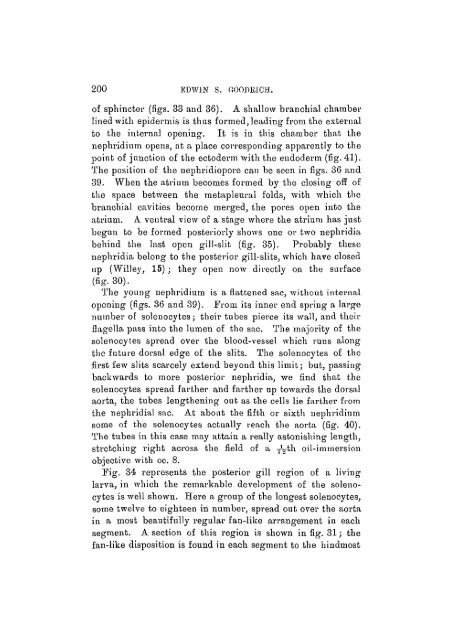On the Structure of the Excretory Organs of Amphioxus. Part 2.—The ...
On the Structure of the Excretory Organs of Amphioxus. Part 2.—The ...
On the Structure of the Excretory Organs of Amphioxus. Part 2.—The ...
You also want an ePaper? Increase the reach of your titles
YUMPU automatically turns print PDFs into web optimized ePapers that Google loves.
200 EDWJN S. GOODRICH.<br />
<strong>of</strong> sphincter (figs. 33 and 36). A shallow branchial chamber<br />
lined with epidermis is thus formed, leading from <strong>the</strong> external<br />
to <strong>the</strong> internal opening. It is in this chamber that <strong>the</strong><br />
nephridium opens, at a place corresponding apparently to <strong>the</strong><br />
point <strong>of</strong> junction <strong>of</strong> <strong>the</strong> ectoderm with <strong>the</strong> endoderm (fig. 41).<br />
The position <strong>of</strong> <strong>the</strong> nephridiopore can be seen in figs. 36 and<br />
39. When <strong>the</strong> atrium becomes formed by <strong>the</strong> closing <strong>of</strong>f <strong>of</strong><br />
<strong>the</strong> space between <strong>the</strong> metapleural folds, with which <strong>the</strong><br />
branchial cavities become merged, <strong>the</strong> pores open into <strong>the</strong><br />
atrium. A ventral view <strong>of</strong> a stage where <strong>the</strong> atrium has just<br />
begun to be formed posteriorly shows one or two nephridia<br />
behind <strong>the</strong> last open gill-slit (fig. 35). Probably <strong>the</strong>se<br />
nephridia belong to <strong>the</strong> posterior gill-slits, which have closed<br />
up (Willey, 15); <strong>the</strong>y open now directly on <strong>the</strong> surface<br />
(fig. 30).<br />
The young nephridium is a flattened sac, without internal<br />
opening (figs. 36 and 39). From its inner end spring a large<br />
number oE solenocytes; <strong>the</strong>ir tubes pierce its wall, and <strong>the</strong>ir<br />
flagella pass into <strong>the</strong> lumen <strong>of</strong> <strong>the</strong> sac. The majority <strong>of</strong> <strong>the</strong><br />
solenocytes spread over <strong>the</strong> blood-vessel which runs along<br />
<strong>the</strong> future dorsal edge <strong>of</strong> <strong>the</strong> slits. The solenocytes <strong>of</strong> <strong>the</strong><br />
first few slits scarcely extend beyond this limit; but, passing<br />
backwards to more posterior nephridia, we find that <strong>the</strong><br />
solenocytes spread far<strong>the</strong>r and far<strong>the</strong>r up towards <strong>the</strong> dorsal<br />
aorta, <strong>the</strong> tubes leng<strong>the</strong>ning out as <strong>the</strong> cells lie far<strong>the</strong>r from<br />
<strong>the</strong> nephridial sac. At about <strong>the</strong> fifth or sixth nephridium<br />
some <strong>of</strong> <strong>the</strong> solenocytes actually reach <strong>the</strong> aorta (fig. 40).<br />
The tubes in this case may attain a really astonishing length,<br />
stretching right across <strong>the</strong> field <strong>of</strong> a T^-th oil-immersion<br />
objective with oc. 8.<br />
Fig. 34 represents <strong>the</strong> posterior gill region <strong>of</strong> a living<br />
larva, in which <strong>the</strong> remarkable development <strong>of</strong> <strong>the</strong> solenocytes<br />
is well shown. Here a group <strong>of</strong> <strong>the</strong> longest solenocytes,<br />
some twelve to eighteen in number, spread out over <strong>the</strong> aorta<br />
in a most beautifully regular fan-like arrangement in each<br />
segment. A section <strong>of</strong> this region is shown in fig. 31; <strong>the</strong><br />
fan-like disposition is found in each segment to <strong>the</strong> hindmost

















